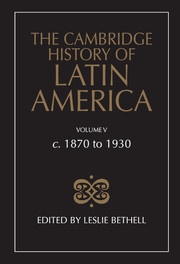Book contents
- Frontmatter
- PART ONE MEXICO
- PART TWO CENTRAL AMERICA AND THE CARIBBEAN
- PART THREE THE RIVER PLATE REPUBLICS
- 9 The growth of the Argentine economy, c. 1870–1914
- 10 Argentina: society and politics, 1880–1916
- 11 Argentina in 1914: the pampas, the interior, Buenos Aires
- 12 Argentina from the first world war to the Revolution of 1930
- 13 The formation of modern Uruguay, c. 1870–1930
- 14 Paraguay from the War of the Triple Alliance to the Chaco War, 1870–1932
- PART FOUR THE ANDEAN REPUBLICSo
- PART FIVE BRAZIL
- Bibliographical essays
- References
11 - Argentina in 1914: the pampas, the interior, Buenos Aires
from PART THREE - THE RIVER PLATE REPUBLICS
Published online by Cambridge University Press: 28 March 2008
- Frontmatter
- PART ONE MEXICO
- PART TWO CENTRAL AMERICA AND THE CARIBBEAN
- PART THREE THE RIVER PLATE REPUBLICS
- 9 The growth of the Argentine economy, c. 1870–1914
- 10 Argentina: society and politics, 1880–1916
- 11 Argentina in 1914: the pampas, the interior, Buenos Aires
- 12 Argentina from the first world war to the Revolution of 1930
- 13 The formation of modern Uruguay, c. 1870–1930
- 14 Paraguay from the War of the Triple Alliance to the Chaco War, 1870–1932
- PART FOUR THE ANDEAN REPUBLICSo
- PART FIVE BRAZIL
- Bibliographical essays
- References
Summary
On the eve of the outbreak of the first world war Argentina had enjoyed since 1880, apart from a quinquennium of depression in the early 1890s, almost 35 years of remarkable economic growth. The main impulse had been exogenous: foreign labour, foreign capital, and favourable foreign markets for its exports. In 1914 around one-third of Argentinas' population of almost eight million, which the third national census showed had increased more than fourfold since the first census in 1869, was foreign-born; at least another quarter was composed of the descendants of immigrants from the past two generations. According to later estimates by the United Nations’ Economic Commission for Latin America (ECLA), in 1914 foreign investments (around 60 per cent of them British), both public and private, accounted for half the country's capital stock, equal to two and a half years of the value of gross domestic production. Since 1900 foreign investment had risen at an annual rate of 11.41 per cent. British investors possessed around 80 per cent of the Argentine railway system, large tracts of its land, most of its tramways and urban utility companies, and some of its meat-packing plants and industries. ECLA again estimated that the annual rate of growth in the rural sector, already 7 per cent between 1895 and 1908, had risen to 9 per cent between 1908 and 1914. In the great compendium it issued on the Republic's affairs in 1911, Lloyd's Bank of London pointed out that whereas until around 1903 the value of foreign trade in Argentina and Brazil was broadly equal, by 1909 Argentina's had grown by half as much again above its leading rival in the subcontinent.
- Type
- Chapter
- Information
- The Cambridge History of Latin America , pp. 393 - 418Publisher: Cambridge University PressPrint publication year: 1986
References
- 1
- Cited by



